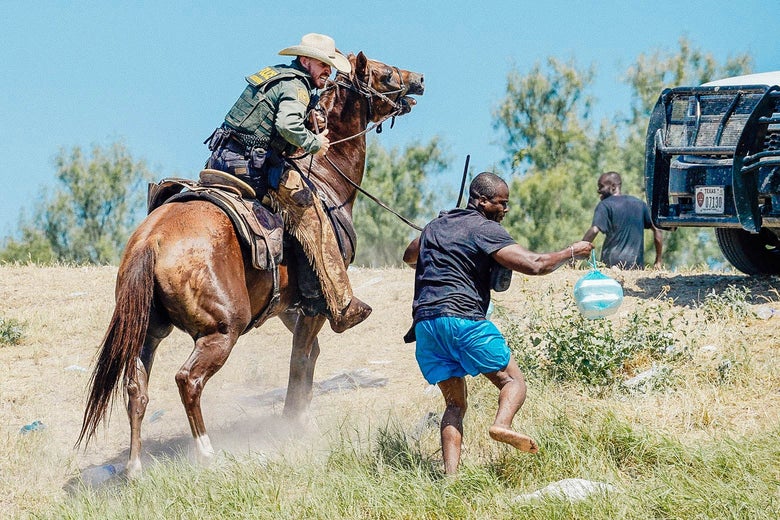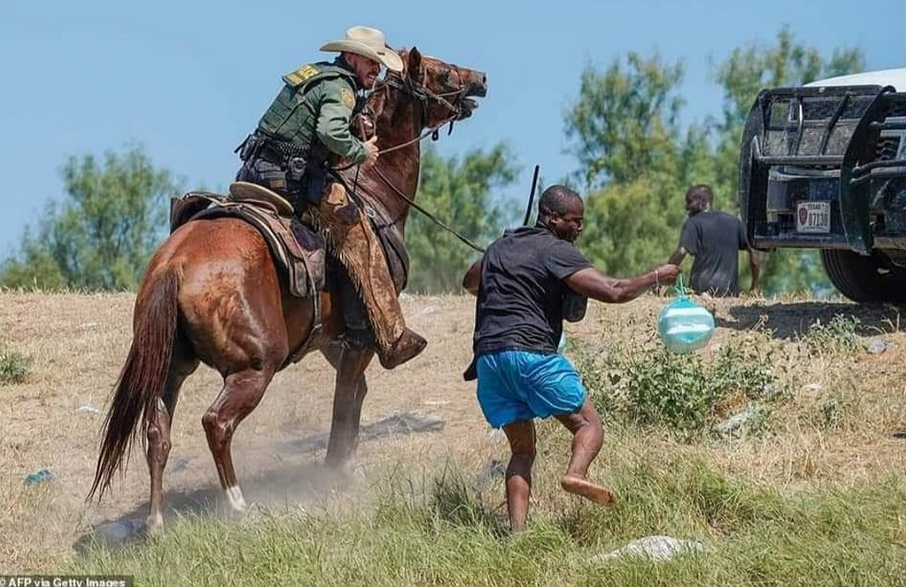
As Haitian migrants carrying food, shoes, and other necessities began to wade into the waters of the Rio Grande earlier this month, some were greeted on American soil by Border Patrol agents mounted on horseback.
Photographs and videos captured the scene: officers chasing migrants back into the water, grabbing migrants by their shirts or in some cases swinging reins in a way that mimicked makeshift whips.* One video shows an agent telling a group of migrants, “This is why your country’s shit. Because you use your women for this”—a message that harkens back to a former president’s view of Haiti and other predominantly Black nations.
Images of the inhumane treatment at the border began to circulate heavily online earlier this week and evoked a plethora of emotion, with some (myself included) drawing parallels to how white men treated Black folks during enslavement and the Jim Crow era, not to mention current day interactions with law enforcement by Black Americans and Black immigrants. (A 2020 report from the Refugee And Immigrant Center details how Haitians were detained more than any other nationality last year and often pay higher bonds.)
In the days since the photos began to circulate on social media, the Biden administration has suspended horse patrols and launched an investigation into the agents’ conduct. “I promise you, those people will pay. There will be an investigation underway now, and there will be consequences. There will be consequences,” said President Joe Biden on Friday. “It’s an embarrassment, but beyond an embarrassment, it is dangerous. It’s wrong, it sends the wrong message around the world, it sends the wrong message at home. It’s simply not who we are.”
Biden’s comments come a day after his U.S. special envoy to Haiti resigned due to the “inhumane, counterproductive decision to deport thousands of Haitian refugees and illegal immigrants to Haiti,” a country that is still rebounding from a political assassination and a deadly earthquake. As of Friday, all the migrants who were in the Del Rio encampment are gone. Around 2,000 were expelled, according to the Associated Press, while CNN reported that others were relocated to DHS processing facilities. About 8,000 voluntarily returned to Mexico where some migrants have been subjected to raidsby Mexican authorities.
Hoping to put this moment in proper historical context, I called Monica Martinez, an associate professor at the University of Texas at Austin and a historian of racist violence in the U.S. We spoke about her research on 20th century border abuses, the Texas Rangers in particular, and why she believes the conversations around anti-Black racism and immigration need to be merged. Our conversation has been edited for length and clarity.
Julia Craven: I hate that our subject matter is what it is, but tell me about the work that you do.
Monica Martinez: My research focuses on Texas in the early 20th century during the Jim Crow era, when laws and policies were put in place to restrict the rights of Black, Mexican, indigenous, and Asian people and women. It’s also a time period of brutal violence by mobs, and by law enforcement—particularly law enforcement on the U.S.-Mexico border. This is the history that’s been hidden. I’ve recovered lynchings, police homicides, and U.S. soldiers shooting children. There have been generations of people calling for justice and trying to have these histories of state sanctioned, racist violence, officially acknowledged. And to have truthful conversations about the past and its relationship to the present.
What’s currently happening with Haitian migrants in Del Rio?
It’s a show of force against Haitian people who are desperately trying to seek asylum in the United States. We’re also seeing that the federal government has been aggressively deporting people back to Haiti—some who have not been in that country for years. And it is a familiar scene because there’s a long history of deportations and sending people to countries that they don’t consider home. There’s also been public attention to the border and what’s happening in Del Rio because there are photographs and video of border patrol officers on horseback charging unarmed civilians.
People who know the history of anti-Mexican and anti-Black violence, especially on the border, were quickly making the connection between the history of the Texas Rangers, which worked as slave catchers and massacred indigenous and Mexican people in Texas. The photographs for people who know this history recalled an earlier era of violence by law enforcement against people on the U.S.-Mexico border.
I’d like to hear more about the Texas Rangers. To me, it was very reminiscent of slave patrols and overseers.
In Texas, and globally, the Rangers are a revered law enforcement agency. They were formed in 1823 when Stephen F. Austin, who was an early Anglo settler in what was then the Northern part of Mexico, organized a group of rangers to “protect” Anglo settlers and their property.
The Texas Rangers [were described] by historians who celebrated them as having an ongoing battle for racial supremacy in Texas. Battling Mexican landowners, indigenous nations—the Rangers targeted what they referred to as “Indian warriors.” But throughout the 19th century, they also played the role of slave catchers. There’s actually some Texas Rangers who were celebrated for their excellent “tracking skills” that were put to use to hunt and capture enslaved people.
The Texas Rangers played a key role in using violence as a tool for social control. Some of the other moments of Texas Ranger history that those photographs reminded me of were the photographs from 1915 that were taken in Texas with a group of Texas Rangers on horseback with their lassos, with ropes tied around the corpses of four men who were identified by the photographer only as “Mexican bandits.”
In 1919, the Texas Rangers were investigated by the state legislature for committing abuses like organizing massacres, making prisoners vulnerable to lynch mobs, shooting prisoners, shooting people just for being Mexican, and denying them due process. State Representative Jose T. Canales filed charges about specific cases of abuse and violence and named specific Rangers, but he also filed charges against the adjutant general and tried to hold the leadership accountable. He made the point that reforming the agency had to be more than firing just a few bad apples. Accountability had to start at the top. In the end, a joint committee of the Texas state Senate and House refused to investigate those charges.
It’s really striking to be having a conversation about abuse by law enforcement and border patrol, because it has been ongoing. The failure to hold Texas Rangers accountable 100 years ago meant that some of those Rangers went on to be inaugural members of the Border Patrol in 1924. It is a moment in time where these histories of racist violence that shaped policing practices for centuries in Texas went on to then shape federal policing practices.
Those photographs gave us a glimpse into some of the techniques that are being used that were caught on camera. But it raises important questions about what we’re not seeing, and what the public doesn’t have access to.
The look on the border patrol officers’ faces—which looked like a mix of disgust and rage to me—got me thinking about how people in power tend to write the narratives and control the initial understanding of things. How does that play into the way that people have been conditioned to view the border and immigrants?
People have been taught that the strength of the nation can be measured by how well it can police and control its borders. During World War One, the United States was trying to create its global presence as a protector of democracy but also as a military strength. So between 1910 and 1920, the years of the Mexican revolution, the U.S. government, to prepare U.S. soldiers to fight in World War One, sent troops to the U.S.-Mexico border. There they practiced using the newest military technologies and digging trenches, using barbed wire, using new tanks, and new machine guns. Americans, for a long time, have been taught that military strength should be on display and the border has been used as a backdrop to show that strength.
The border has been represented as a dangerous place for white people and as a place in need of policing and where the freedom of movement should be restricted. This has cast suspicion on people who live near the border, and people who live in border communities have been cast as dangerous and violent—whether they’re American citizens or not.
How does a law enforcement officer appearing to whip a Black person fit into that broader picture of law enforcement officers not respecting the human rights of people of color?
The force [against Haitian migrants by Border Patrol] is unsettling to see—and you don’t have to be a student of history for it to be familiar. But, I think that most people have not considered the abuses that have taken place on the border by law enforcement when discussing policing reforms. That’s a needed and urgent conversation. I would say, too, that most people don’t see it as an issue in which anti-Black racism shapes immigration policy. It really raises important questions about what does humanity look like in the United States?
And who is considered to be human.
Absolutely. It comes back to the history of the United States restricting who was considered human and who was considered worthy of being a citizen. It’s a series of conversations that we’ve had since the founding of the nation. We are having that same conversation when it comes to immigration but we don’t often think about it in terms of how is it that some people are deemed desirable and others are not. And it gets to this very hard question of the inhumane treatment of people on a person-to-person basis that is deeply troubling.
Update, September 25, 2021: This post was updated to clarify imprecise language about how the Border Patrol agents were using the reins.
